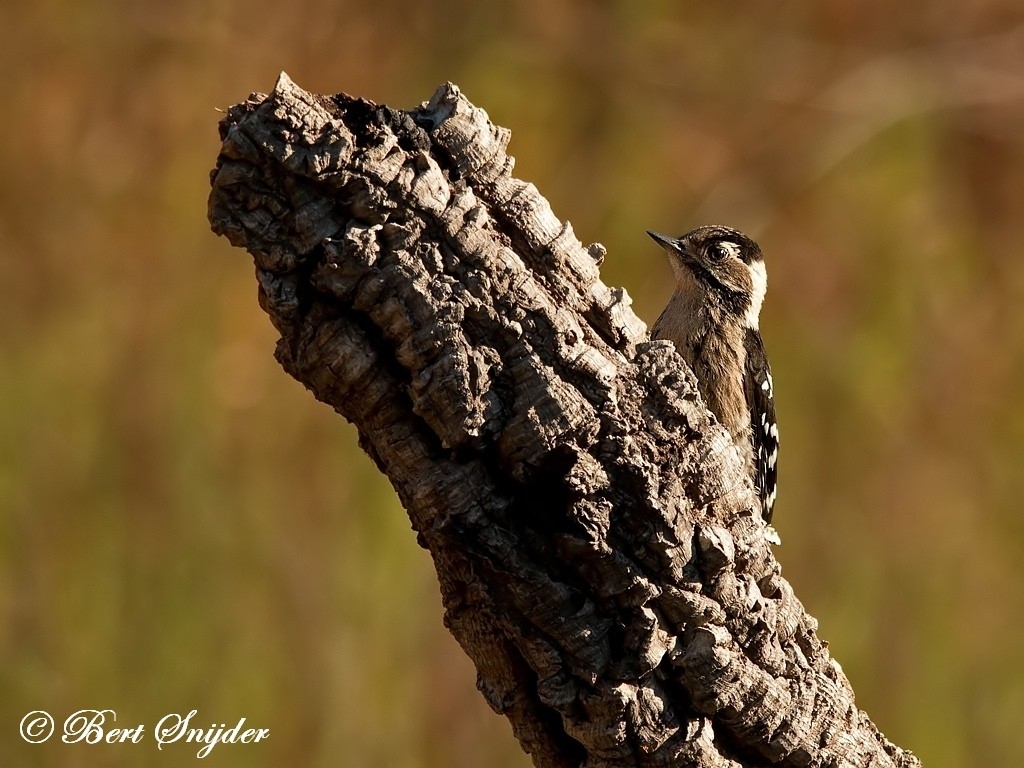Lesser Spotted Woodpecker, Kleine Bonte Specht, Kleinspecht, Pica-pau-malhado-pequeno, Pico menor
Spotted on our property Monte Horizonte in the Alentejo region of Portugal. Lesser Spotted Woodpecker sound
The Lesser Spotted Woodpecker (Picoides minor) is a member of the woodpecker family Picidae. It was previously assigned to the genus Dendrocopos (sometimes incorrectly spelt as Dendrocopus), and often still is, but it appears to be closer related to the Downy Woodpecker.

The range of the Lesser Spotted Woodpecker is the Palearctic region, but several subspecies are recognised.
From its small size and its habit of spending most of its time in the tops of tall trees in woods and parks, this little woodpecker is often overlooked, but if sighted on a trunk it may at once be identified by the broad barring on the wings and narrower bars across the lower back.
The male has a crimson crown, a brown forehead, a black superciliary stripe, and another from the base of the bill to the neck. The nape and upper back are black, but the lower back is barred with black and white. On the wings are broader and more conspicuous bars, and the outer tail feathers are also barred. The under parts are white with streaks on the flanks. The bill and legs are slate-grey.
In the female the crown is white, but the young birds of both sexes have more or less crimson on the head. There are no marked seasonal changes.
Its habits are very similar to those of the Great Spotted Woodpecker, and it has the same stumpy appearance, almost triangular, when bounding from tree to tree. Its note is a repeated “keek”, loud for so small a bird, and its vibrating rattle can with experience be distinguished from that of the larger species. This substitute for a song may be heard at all times, but most frequently when courtship begins early in the year.
Its insect food is similar to that of the Great Spotted Woodpecker. When hunting for wood-boring larvae it chips away at the rotten wood, and the litter at the foot of a tree is often the first indication that insects are attacking upper branches. From autumn to spring it hunts mainly on wood-living insect larvae, frequently from thin dead branches in living trees. Through the breeding season, surface-living insects from the foliage and bark of trees make up an increased amount of the diet. Nestlings are mainly fed with surface-living insects,such as aphids and larval insects. At night it roosts in old holes.
A litter of chips is also a guide to a nesting hole, for the bird does not always carry these away when excavating. The hole is usually at a considerable height above the ground and may be so high as 30 or 40 feet. It is a smaller burrow than that of the Great Spotted Woodpecker, measuring from 1 to 2 inches in diameter.
The shaft varies, the nesting cavity being often a foot or more below the entrance. Five to eight highly polished white eggs are laid upon wood dust and chips in the latter half of May, and a single brood is the rule. Both birds help to incubate. Occasionally an old or natural hollow is used or enlarged.
Populations of Lesser Spotted Woodpeckers are mostly resident, but can be nomadic to some degree. Annual fluctations in population numbers are common. The winter temperatures may exhibit a direct effect on winter survival of Lesser Spotted Woodpeckers by heat loss, whereas weather conditions during spring have an indirect effect on breeding performance by affecting food production.
Other synonyms:
Asturian: Piquetín
Breton: Ar marc’h-koad bihan, Kazeg-koad bihan, pilkoad bihan
Catalan: Picot garser gros, Picot garser petit
Valencian: Picot garser gros
Czech: Strakapoud malý
Welsh: Cnocell brith bach, Cnocell brith lleiaf, cnocell fraith leiaf, Coblyn lleiaf, Delor fraith leiaf
Danish: dværgspætte, Lille flagspætte, Lilleflagspætte
German: Kleiner Buntspecht, Kleinspecht, Zwergspecht
English: Lesser Pied Woodpecker, Lesser Spotted Woodpecker
Esperanto: malgranda buntpego
Spanish: Carpinterito Manchado Pequeño, Pico Menor, Pico minor
Estonian: Väike-kirjurähn
Basque: okil txiki, Okil txikia, Picot garser petit
Finnish: Pikkutikka
Faroese: dvørgspæta
French: Pic épeichette
Friulian: Pic de corone, pic piçul
Frisian: lytse eksterspjocht
Irish: mionchnagaire breac, peto
Gaelic: Snagan Daraich Beag
Galician: Peto pequeno, Peto real, Picot garser petit
Manx: snoggeyder breck
Croatian: mali djetao
Hungarian: Kis fakopáncs
Armenian: Pokr Paytpor
Icelandic: Stubbspæta
Italian: Picchio rosso minore
Japanese: koakagera, Ko-aka-gera, koaka-gera
Cornish: Casek-cos bryth lyha, Kasek koes vrith, kasek koes vrith vyghan
Latin: Dendrocopos minor, Dendrocopus minor, Picoides minor
Ladino: becalen pice
Ladin: Becalen gran
Lithuanian: Mažasis genys, mažasis margasis genys
Latvian: mazais dzenis
Dutch: Kleine Bonte Specht
Norwegian: Dvergspett, Liten flaggspett
Occitan: Pic mar, pic pichòt
Polish: Dzieciol bialogrzbiety
Portuguese: pica pau malhado pequeno, Pica-pau-malhado-pequeno, Picapau-malhado-pequeno
Romansh: Pitgalain grond, pitgalain pitschen
Romanian: ciocanitoare
Russian: dalyj djatel, Maly Pyostry Dyatel
Sardinian: Biccalinna pistrincu, Biccalinna piticu, Biccamatta pistrincu, Biccamatta piticu, Biccamuru pistrincu, Biccamuru piticu
Scots: cnag bheag, Snagan daraich beag
Northern Sami: Deaggacáihni
Slovenian: mali detel
Albanian: Qukapiku i vogël larosh, qukapiku larosh i vogël
Swedish: Mindre hackspett
Sorbian, Upper: Dypak, Dypornak
Travel Birdwatching Holiday Alentejo, Vacation Portugal for birders guided birdwatching Tours and Trips.